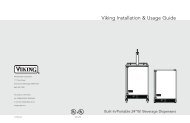ASKO D5152 Operating Instructions Dishwasher
ASKO D5152 Operating Instructions Dishwasher
ASKO D5152 Operating Instructions Dishwasher
Create successful ePaper yourself
Turn your PDF publications into a flip-book with our unique Google optimized e-Paper software.
10<br />
Basic Course<br />
Below are step-by-step instructions to help you<br />
achieve the best possible dishwashing results.<br />
Load the baskets correctly!<br />
Thanks to Self Cleaning System, you<br />
do not need to rinse the dishes under running<br />
water. Simply remove large food particles<br />
and debris. Convenient and environmentally-friendly!<br />
Place glasses, cups, bowls, side plates, and<br />
saucers in the upper basket. Wine glasses<br />
should be hung from or leaned against the<br />
wine glass shelf and knives placed in the knife<br />
stand if present.<br />
Note!<br />
Ensure that all soiled surfaces face inwards<br />
or downwards!<br />
Place dinner plates, side plates, serving<br />
dishes, saucepans, and cutlery (in the cutlery<br />
basket) in the lower basket. The removable<br />
plate insert, which comes with certain<br />
models, can be easily removed to provide<br />
room for large plates, saucepans, and pots, or<br />
placed in three alternative positions.<br />
Stand the cutlery with handles downward<br />
and as spread out as possible. Ensure that<br />
spoons are not resting inside each other.<br />
Do not put cutlery made of different materials<br />
- such as silver and stainless steel - in<br />
the same compartment (risk of stains).<br />
The cutlery basket has a folding flap in the<br />
middle for small items or narrow shafts, such<br />
as electric whisks.<br />
Place long cutlery and carving knives in the<br />
Customer Care Center<br />
1-800-898-1879<br />
www.askousa.com<br />
special knife box (if present) or in the upper<br />
basket.<br />
Check that the spray arms are able to<br />
move freely.<br />
See the section entitled Fragile Dishes if you<br />
want to wash objects that may be fragile.<br />
Dishwashing detergent<br />
We recommend that you use<br />
only unscented, granular automatic dishwashing<br />
detergent. Using the wrong detergent<br />
could cause flooding and/or damage<br />
your dishwasher. Do not use detergent that<br />
has been wet and is clumped. Also, check<br />
the expiration date on the container.<br />
The amount of detergent needed can vary<br />
due to differences in water hardness. To<br />
determine the water hardness in your area,<br />
contact your local water utility or area water<br />
softening company. The harder the water,<br />
the more detergent you may need. Refer to<br />
the chart below for the recommended detergent<br />
amounts based on water hardness.<br />
Remember, you should adjust the amount<br />
of detergent you use by small amounts<br />
until you find the correct amount.<br />
Twelve grains and higher is extremely<br />
hard water and detergent alone may not<br />
be enough. You may need to use a water<br />
softener to maximize the performance of<br />
your dishwasher. Also, in areas with hard<br />
water (9+) you may need to wash at lower<br />
temperatures to prevent hard water deposits<br />
from forming in tank and wash system.<br />
In hard water areas, both the dishes and<br />
the machine can develop a white or gray




